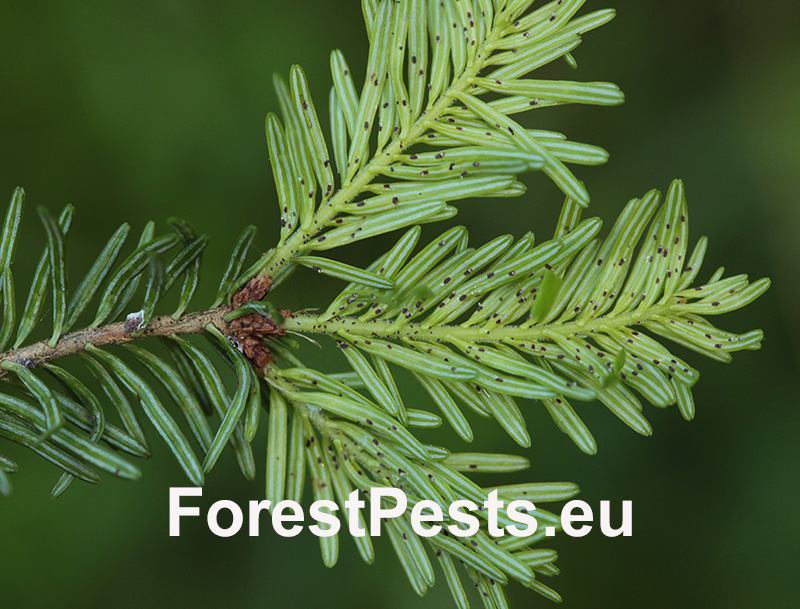Dreyfusia nordmannianae
The silver fir woolly adelgid has two hosts in its native range, the primary host - oriental spruce (Picea orientalis) and the secondary host - Caucasian fir (Abies nordmanniana). The development of the sexual generation takes place on the primary host and galls form on it. In the country of origin, the development of D. nordmannianae takes two years.
In Europe, the development is shorter, lasts only one year, and exclusively on fir. The pest overwinters as a first instar larva on the trunk and branches of trees. As soon as the temperature rises in early spring, the larvae develop rapidly through the second and third stages to the wingless female (fundatrix), which begin to lay eggs (from 300 to 500 pieces). Two different types of larvae hatch from these eggs in early May. First, larvae (sistens) settle on the trunk, where they suck plant juices. They have an extended straw-like sucking organ. These larvae no longer develop that year and remain on the trunk until autumn, where they overwinter. The second type of larvae (progrediens) moves into newly formed needles and fir shoots. It has a significantly shorter sucking organ. On the needles, these larvae are visible as tiny black dots. They suck for several weeks and gradually change into two types of adult females through four developmental stages. One type is winged and flies over a secondary host - the Caucasian fir. In Europe, this type of female species dies. The second type of female species is not winged and begins to lay eggs. Their fertility is low; they lay only 10 - 15 eggs. In July and August, larvae hatch from the eggs. They move on the trunk, joining the sistens, who have been feeding there since spring. All the larvae on the trunk are covered with a layer of white waxy wool at the end of September and the beginning of October. Under the layer of waxy wool, they overwinter until spring. In the spring, they continue to develop, they change into female fundatrix, and the whole cycle repeats.
The damage to young firs (Abies alba) is caused by the sucking of larvae on needles and twigs. The needles on the new shoots twist downwards due to sucking, turn yellow, and shorten. The needles affected by a weaker attack are only a bit shorter than the unaffected ones. In the case of a heavy attack, the needles grow only to a length of 0.5 - 1 cm, and the shoots are deformed, shortened, brown, and dry. In addition, the shoots are swollen at the base. In 10-year-old firs, the growth is reduced to 5-6 cm. The terminal and lateral shoots and whole individuals gradually die. A suitable pest detection method is to control the presence of deformed needles and branches.
The damage is characteristic and can be confused in the initial stage of the occurrence only with the damages caused by abiotic factors (frost, immissions, lack of nutrition).
The area of its native range is the Caucasus, the mountains of eastern Pont (Turkey), and Crimea. In its region of origin, the host trees are Picea orientalis and Abies nordmanniana. Since 1840, in connection with the introduction of its host plants, it has dispersed across Europe.
Here, due to the absence of natural enemies, it became a significant pest influencing the mortality of young fir stands. This pest doesn't attack the Norway spruce (Picea abies), one of the most important tree species in Europe. However, it has become established, and in Europe, it regularly reproduces on silver fir (Abies alba). Furthermore, it often breeds in dry, warm habitats. The pest appears in the area of Banská Bystrica, Staré Hory, Slovenská Ľupča, and in some other localities in Slovakia.
Generally speaking, it appears to be established throughout much of the range of fir. Still, it is most abundant in the area of the central mountains of Slovakia (around Banská Bystrica, Staré Hory, Slovenská Ľupča, Low Tatras, Veľká Fatra) at medium altitudes around 600 - 1000 m above sea level. It prefers young firs (up to 20 - 30 years) grown without the protection of the mature stand. It occurs in localities in different intensities depending on the climatic conditions. Chronic tree infestation reduces growth, contributes to loss of vitality, and causes mortality.








